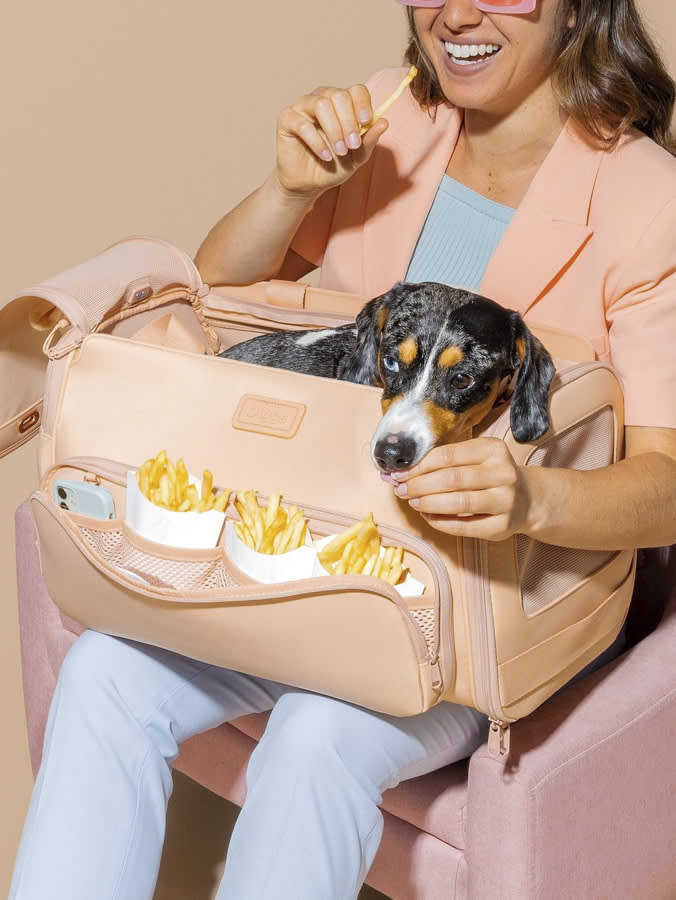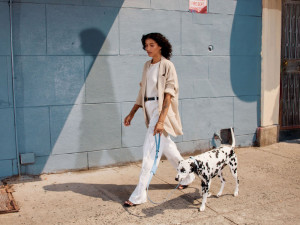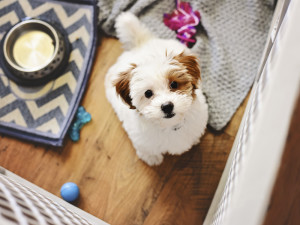Terrified of Your Dog’s Impossible-to-Assemble Crate?
Diggs has the answer.

share article
Dogs need stuff. Like, a lot of stuff. Between collarsopens in a new tab, treats, toysopens in a new tab, gates, and a seemingly endless stream of poop bags, our dogs’ stuff can start to take over our lives. Of this stuff, some is downright ugly (looking at you, perpetually crusty Kong opens in a new tabthat my dog refuses to trade in for a newer cleaner version). Some is annoying (see: aforementioned endless stream of poop bags that refuse to rip off on the first time), and some is both annoying and ugly — hello, pee padsopens in a new tab.
The wireframe crate that haunts our living rooms, ready to clang and pinch at a moment’s notice, is absolutely, unequivocally both.
That’s why Zel Crampton started Diggsopens in a new tab and launched the premium brand with Revolopens in a new tab, a modern, aesthetically pleasing crate that helps train, contain, and transport your dog with ease. Inspired by his own pup, Louise, and utilizing his background as an engineer and a life-long animal lover, Crampton created Revol after years of research, design, and rigorous safety training.
The Wildest sat down with the Digg founder to chat about his inspired journey to create the Revol crate (with Louise’s help of course) and what problems Diggs is ready to solve next.
Tell us a little bit about your history with the pets in your life and how that inspired you to create Diggs.
I like to joke that there’s pet owners, pet parents, and pet nuts, and I’m in some undefined category. In 2011, I started to become exposed to the pet industry and started to get really excited about how things were changing with pets starting to become more humanized and treated better.
Then, when I got my rescue, Louise, in 2016, I went to go buy the typical pet supplies you buy for a puppy: crates opens in a new taband leashes and collars, etc. I was kind of amazed at how low-quality, ugly, and unsafe a lot of the pet products on the market were. Take a look at crates, for example. Certainly at the time, everything was a black wire created super cheap and oftentimes unsafe. At the same time, my friends were buying homes and having kids for the first time, so I became exposed to brands and other consumer categories like the baby space or Dysonopens in a new tab or Simple Human.
All of these brands were once overlooked, mundane consumer categories and [their manufacturers] elevated them to safety, the quality of the functionality, the design, aesthetic, everything and I said, “Hey, theres got to be room for that in the pet space” just given the way we all think about our pets these days. So I set out to build a brand just like that. And that was the inspiration for Diggs.
And that’s how you came to have a “problem solving” philosophy behind Diggs products?
You know, I come from a background of engineering and have a passion for design. And one of the fundamental things you learn as an engineer is you don’t make something just because you think it’s a good idea or it’s cool; you have to solve a real problem.
You go into peoples’ homes, you go to dog parks, and you actually observe how people interact with their dogs [and] interact with products. I was amazed how much consumers fumbled and pinched their fingers when it came to setting up the dog crate. That’s actually what led us to, sort of, how we designed our Revol dog crate.
What actually makes the Revol dog crate different from other dog crates?
In our research, we uncovered four major issues when it came to dog crates: Number one was the aesthetic. They got to look beautiful in your home. They sit in the middle of your living room and people want to be proud of what they put in their homes. The second is safety and quality. Making sure that the product is safe and not just safe...but also safe when you have children in the home. Typical wire crates today are only ever expected to pass 40 pounds of static load on the top of the crate.
Number three is what I would just call general ergonomics. With these black-wire crates you often have these slide latches, which are very fiddly for humans to use, but dogs have actually figured out how open them. [Our door] is escape-proof for the dog and just feels like a regular door handle for the pet owner.
The last piece is transportability; people want to take their crates with them and basic wire crates are infamous for being difficult to collapse, so we developed a revolutionary collapsing mechanism where just with a twist of a handle your crate collapses in seconds.
Given your passion for consumer safety in the pet space, what would be your advice for pet parents when choosing safe products for their pets?
I think that I would offer a little bit of the obvious, which is do your homework. What that really means is talk to professionals, particularly trainers and certified trainersopens in a new tab in particular. They’re the best folks to talk you through what kind of products they recommend and why and — most importantly — how to use products safely. Any product can be dangerous or weaponized when used incorrectly. The most important thing is to use products as intended.
I also think the one thing I would be most careful about is going for only the cheapest brands or brands that are designed just for the pet parent and not the dog. When choosing pet products, consider if you have thought about what makes dogs different from humans. As much as we want to humanize our pets and treat them like our babiesopens in a new tab, they are still dogs, and they need things that are unique to their physiology and psychology. And as long as you’re catering to that, I think you’ll be setting yourself up for success.
What’s next for Diggs?
Over the next year and a half, we’re going to be launching some amazing products in the carrier space, as well as different kinds of crate products and expanding on our accessories for our Revol crate. We’re also branching out into things like play pens and gates — really focusing on building out our suite of premium products in the containment space.

Rebecca Caplan
Rebecca Caplan is a writer based in Brooklyn whose work has been featured in The New Yorker, Reductress, and Vulture. She lives in Brooklyn with her perfect, toothless dog Moose.
Related articles
![a woman walks a large dog on a blue leash]() opens in a new tab
opens in a new tabEvery Imaginative Product Fable Makes Has a Story
The brand’s founders design elevated pet essentials, from a sustainable-wood crate to a game-changing toy to a hands-free leash.
![puppy jumping up on crate]() opens in a new tab
opens in a new tabGimme Shelter: The Best Dog Crates
Spend less time searching for your dog’s house than you do on Zillow.
![A cute puppy looking up at the camera]() opens in a new tab
opens in a new tabWhen it Comes to Dog Crates, Think Outside the Literal Box
How to treat and prevent confinement anxiety.


